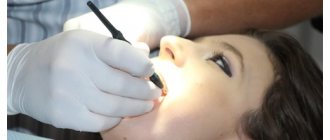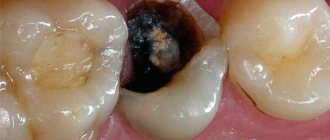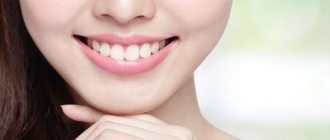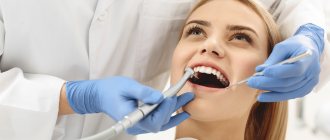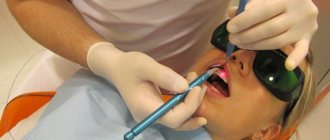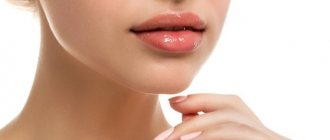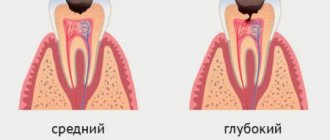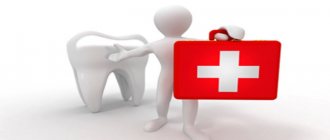01.12.2019
If unexpected pulpitis occurs during gestation, there is nothing left to do but immediately go to the dentist for help. Many women are anxiously wondering how safe arsenic can be during pregnancy. In the process of dental treatment for pregnant women, two doctors should take part - a dentist and an obstetrician-gynecologist who monitors the course of pregnancy.
Therapy
| Service | price, rub. |
| Primary consultation and examination with a doctor | For free |
| Initial consultation with an implantologist, orthodontist, orthopedist (orthopantomogram is required) | For free |
| Examination by a doctor with prescription of medication | 500 |
| Help for antenatal clinics, hospitals, sanatoriums | 500 |
| TREATMENT OF CARIES | |
| Treatment of caries “without drilling” ICON technology – 1 tooth | 2500 |
| Treatment of caries (filling, anesthesia, lining) | 2400 — 3800 |
| Treatment of deep caries (filling, anesthesia, x-ray, lining) | 3000 — 4500 |
| Artistic tooth restoration (frontal group of teeth) | 4700 — 6350 |
| Restoration of a chewing tooth (filling, anesthesia, x-ray, pin) | 3000 — 4650 |
| NERVE REMOVAL – CANAL TREATMENT (depulpation) is carried out in two visits, payment in stages | |
| Treatment of pulpitis of a 1-canal tooth, without the cost of a filling | 3700 — 4800 |
| Treatment of pulpitis of a 2-channel tooth, without the cost of a filling | 5700 — 6800 |
| Treatment of pulpitis of a 3-channel tooth, without the cost of a filling | 7700 — 9800 |
| Treatment of pulpitis of a 4-channel tooth, without the cost of a filling | 9700 — 11000 |
| Installing a seal | 2800 — 3200 |
Initial consultation is free.
Basic recommendations
After visiting the dental office, you need to follow some rules:
- It is forbidden to eat or drink anything for 2-3 hours. During this time, the filling should become hard and not break due to food.
- Find out from your attending physician whether you can drink alcohol during this treatment, and for how many days the restriction on drinks and food is in effect.
- If you suddenly have a sour taste in your mouth, you can rinse it with a baking soda solution.
- To neutralize the effect of a toxic compound when it enters the body, drink milk and cottage cheese. It is important to wear the filling no longer than the specified date and to remove it on time. Modern products contain a smaller amount of the chemical element, so you can wear a filling for up to 1 week.
Recommendations! You can drink a glass of milk to neutralize the compounds of the substance if your health worsens and at the same time urgently call a doctor.
Painless pulp removal
Teeth cleaning
| Service | price, rub. |
| Initial consultation with a doctor | For free |
| Comprehensive professional hygiene (including ultrasonic removal of dental plaque, Air-flow, polishing, varnish coating) Promotion | 4000 3600 |
| Ultrasound removal of tartar – 1 tooth | 300 |
| Removal of pigment plaque with the “Air-flow” system – 1 tooth | 300 |
| Plaque removal using the Air-flow method – 2 jaws | 3000 |
| Ultrasonic dental plaque removal – 2 jaws | 3000 |
| Preventive fluoridation of teeth with GELATO – 2 jaws | 800 |
| Using the Optra Gate disposable retractor | 350 |
| Teeth whitening Opalescence Boost | 10000 |
| Skyce installation (including the cost of decoration) | 2000 |
All initial consultations are free.
Nerve removal during pregnancy
Even women who have exemplarily tidied up their teeth at the stage of pregnancy planning are sometimes faced with the need to treat them during the difficult but joyful period of waiting for the baby. What can we say about the ladies for whom the conception of a child was a surprise for which they did not have time to properly prepare?
Removal of the tooth nerve during pregnancy is necessary to treat pulpitis or periodontitis. Both diseases are a complication of caries, which for some reason was not detected or treated in a timely manner.
Any caries should be treated immediately, without delay. And the best prevention is a regular preventive examination by a dentist and professional hygiene specialist twice a year.
Anesthesia, painkillers and antibiotics
Anesthetics during pregnancy are dangerous because they can penetrate the placenta and also increase blood pressure due to the high content of adrenaline. However, its concentration in a ratio of 1:200,000 has been proven to be safe for both mother and child. It is recommended to use ultracaine and ubistezin as pain-relieving injections during pregnancy. And it is better not to use lidocaine, which is more popular in dentistry, as a “freeze”: it causes cramps and muscle weakness. Also, during pregnancy, anesthesia is strictly prohibited. If complex treatment or tooth extraction cannot be avoided, the doctor may prescribe painkillers to the patient. Ibuprofen and paracetamol are considered the safest during pregnancy, but you need to keep in mind that taking ibuprofen is not recommended in the 3rd trimester. Antibiotics should also be avoided by expectant mothers, but if there is a risk of complications and the development of bacterial infections, drugs from the group of penicillins and cephalosporins are acceptable.
The service is provided
Zohiri Khoja Zakirovich Therapy, orthopedics
Branch: Pavshinsky, 17
Make an appointment with a specialist
Osipova Irina Gennadievna Therapy, general dentistry
Branch: Pavshinsky, 17
Make an appointment with a specialist
Should a tooth be pulped during pregnancy?
Many patients know that the nerve has to be removed if pulpitis begins. It is always accompanied by pain, a reaction to cold and hot, often a rise in temperature, and night pain.
Is it possible to depulp a tooth during pregnancy? Any dentist will say: “Yes.” If pulpitis begins, then removal of the tooth nerve during pregnancy is necessary.
Pulpitis is an acute inflammatory disease. It is impossible to stop it without removing the source of inflammation. Pulp pain is one of the most severe, and therefore it is impossible to endure and wait for the tooth to “calm down” under any circumstances. In addition, even if the tooth aches and hurts periodically, delay in treatment will lead to the development of periodontitis - an even more formidable and serious disease.
Current promotions!
Implantation in installments regularly
The promotion operates regularly and applies to patients who require implantation.
How to avoid nerve removal
As mentioned above, pulpitis is a complication of caries. Normally, the crown of the tooth is covered by enamel, and underneath it is a layer of dentin. In the cavity of the tooth there is a pulp chamber in which the neurovascular bundle is located - this is the pulp.
With the development of caries, enamel and dentin are affected, and a focus of inflammation appears. As soon as it passes into the pulp chamber, pulpitis occurs, this is inflammation of the neurovascular bundle.
The development of caries occurs gradually: the spot stage (damage to the enamel), then superficial caries, then deep. This is how the primary process occurs. The second option is secondary caries. It develops on a previously treated tooth, maybe in a place where a filling has fallen out or directly under an old filling.
The best way to avoid nerve removal during pregnancy is regular preventive examinations, professional hygiene before and during pregnancy, and timely treatment of caries.
I fixed all my teeth and here I go again...
Our doctors regularly hear from pregnant patients: “I had all my teeth treated before pregnancy, and now I need to put fillings in again. How so?"
During pregnancy, the whole body experiences stress:
- changes in hormonal status;
- global decrease in immunity;
- exacerbation of chronic diseases;
- increased pathogenicity of microflora;
- the appearance of allergies;
- manifestation of diseases that the patient did not suffer from before pregnancy.
The condition of the oral cavity also changes during pregnancy. Caries appears more often and progresses faster. Good hygiene requires much more effort, and the condition of the gums worries every second pregnant patient. All this increases the likelihood of developing pulpitis during pregnancy.
Photos of the dental offices of the clinic Our Dentist in Krasnogorsk
(images are clickable)
When is the best time to remove a nerve during pregnancy?
The best time for dental treatment during pregnancy is considered to be the second trimester. During this period, the placenta maximally protects the fetus from negative influences, the formation of organs and systems is already behind us, and the risk of miscarriage is minimal.
However, pulpitis is usually accompanied by acute pain, which is an indication for immediate intervention. In addition, delay invariably leads to periodontitis - a more severe and formidable disease when inflammation from the tooth cavity spreads to the tissues surrounding the tooth.
Therefore, removal of the nerve of a tooth is carried out for pregnant women at any stage: severe pain syndrome is a strong stress that negatively affects the condition of the woman and child, and significantly increases the risk of miscarriage.
How is nerve removal performed for pregnant women?
Treatment of pulpitis is usually carried out in two visits. The doctor does not use x-rays, relying on objective and clinical symptoms of the disease, such as the intensity and nature of pain, reaction to temperature stimuli, and external signs of inflammation.
The dentist collects a detailed medical history, conducts examination, percussion, and palpation. In case of a questionable picture, the doctor can additionally use electroodontometry for differential diagnosis.
In general, the process of depulpation itself differs little from the treatment of pulpitis outside pregnancy. Under local anesthesia, the doctor removes pathologically altered tooth tissue, expands and processes the canals, and removes the neurovascular bundle. The canal is sealed and a temporary filling is placed. After a few days, a permanent filling can be installed.
Features of root canal treatment in pregnant women
- Potentially painful procedures are performed under local injection anesthesia. The anesthetic used to remove the nerve does not contain adrenaline and is approved for use by children and pregnant women.
- When removing a nerve during pregnancy, X-rays are not used. Other methods are used for diagnosis, and a control image is recommended to be taken after childbirth.
- To treat root canals during pregnancy, the doctor does not use drugs containing formaldehyde, arsenic, lidocaine and other toxic substances.
- During the treatment process, the doctor takes short breaks so that the pregnant patient can rest, change her position, and walk around.
- If there is post-filling pain, the patient is prescribed paracetamol, explaining that other painkillers are not recommended in her situation.
Treatment of pregnant women in Krasnogorsk
The dentists of the “Our Dentist” clinic have long and successfully treated the teeth of women with different stages of pregnancy. Our specialists will carry out all the necessary procedures carefully, in the most comfortable and safe environment for expectant mothers and their babies.
Call and schedule a free consultation and preventive examination.
Your calls are always welcome! 8 915-367-04-47 - call, make an appointment, come for a free initial consultation, and Our Dentist will become yours!
Dear patients! All prices on the site are valid only at the time of publication. The specialist will inform you about the exact cost and scope of necessary procedures after consultation.
Author of the material: Chief Dentistry Doctor “Our Dentist” Oleg Nikolevich Sharmay.
In what form is arsenic administered?
Arsenic can be found everywhere. There is nothing superfluous in nature. The uniqueness of this chemical element from the periodic table is that it can be found everywhere:
- in rocks;
- in minerals;
- in drinking water;
- in animal and plant tissues.
Arsenic is rightly called the “ubiquitous” element. It is distributed throughout all continents of the planet due to its volatility and ability to quickly dissolve in water. In surface waters, from 3 µg/liter to 10 µg/liter of the substance is observed. Arsenic is contained in the human body in adults up to 15 milligrams. It “lives” in the cells of the liver, lungs, and epithelium of the small intestine. Absorption of the substance occurs in the stomach and large intestine.
In ancient times, high doses of arsenic were used to kill rodents, as a result of which the element still has such a “telling” name. Arsenic has unique properties. In small doses, it performs a number of useful functions for vital processes in organs and tissues. And in large doses it is very toxic and leads to cell death of any etiology. Arsenic takes part in metabolic processes and protein synthesis, promotes the absorption of phosphorus and nitrogen, stimulates hematopoietic function, and weakens oxidative processes in the body.
In dental practice, arsenic is not used in its pure form. It is the main component of arsenic pastes, which the doctor places into the tooth cavity formed as a result of destruction for complete necrosis of the nerve and subsequent painless cleansing of the dental canal. The devitalizing paste contains the following ingredients:
- pain reliever (30%);
- arsenic aldehyde (35%);
- antiseptic (5%);
- tannin (1%);
- preservatives.
Arsenic paste impairs trophism at the cellular level of any tissue and stops the blood supply to the pulp, which ultimately completely interrupts the transmission of nerve impulses from nerve cells. Thus, the toothache subsides, the doctor is able to completely clean the canal and fill it with filling material.

